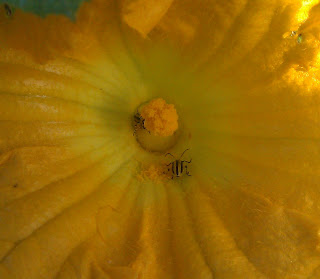It has been an interesting
week. We have had more bug battles;
cucumber beetle, flea beetle, whitefly, aphids, cabbage moth and slugs. I’m
still on my Neem/ Pyganic spray which seems to be holding the populations of
cucumber beetle, flea beetle down, but of course they and their damage are
still evident in the garden. I have also
ordered 2000 green lace wing eggs to release in both of the greenhouses, and I
am hoping they will take care of the last of the whiteflies and aphids. In the
larval stage they are voracious eaters consuming more than 200 insects each
before they mature. For the slugs I found an organic bait made by Espoma, which
seems to be working, and a consistent spray regimen of Dipel (an organic Bt) is
working well for the cabbage worms. Organic
gardening requires targeting individual insects with individual solutions,
where as conventional agriculture takes a “kill em all” approach. Sevin, for
example is something a lot of people use in their conventional gardens to great
success, killing all pests in sight. Unfortunately they are also potentially
killing earthworms, honey bees, bumble bees lady bugs as well as a plethora of
other beneficial insects and soil microbes.
Ok, enough
about insects, lets talk about tomatoes.
We put in our second generation of tomatoes this week, and the rain is
watering them in nicely. I like to do two plantings in the garden because even
though they are all indeterminate varieties (meaning they ripen over a period
of time, as opposed to determinate varieties which all ripen at once) they
still have a time of peak production which it is better to space out. For
slicing tomatoes we went pretty basic this year with a few classic red heirloom
varieties like Moskovich and Mule Team, and backed them up with a few hybrids
such as Martha Washington and Orange Blossom.
I put in a sun drying variety as well called Principe Borghesi , which
has a low water content so that the fruit can be sliced in half and dried in
the greenhouse in just a few hours. For cherry tomatoes we have a wider
variety; red and yellow pear, red, yellow and pink grape, a red round cherry
and of course sun gold (voted as the sweetest cherry tomato). The currant tomatoes have all been planted in
hanging baskets to make them easier to pick.
Sweet Pea was the favorite last year so mostly I have planted those with
a few Tess’s Land Race, and Red Delicious Currant. And last but certainly not
least Husk Cherries, also known as Pineapple Tomatillos or Cape Gooseberries
This week
we are harvesting lettuce, frisee, kohlrabi, beets, turnips, radishes, broccoli,
swiss chard, pac choi, and strawberries.
Also keep your eye out for wild mulberry trees, the fruit is perfect
right now, and very easy to pick. Hopefully next week when I check in I’ll
still be winning my bug battles, and we will have a few more items on the
harvest list such as sour cherries and fennel. See you then.
(baby broccoli growing away)
(How the garden grows - it's remarkably tall for the end of May.)





No comments:
Post a Comment
Thanks so much for your feedback!